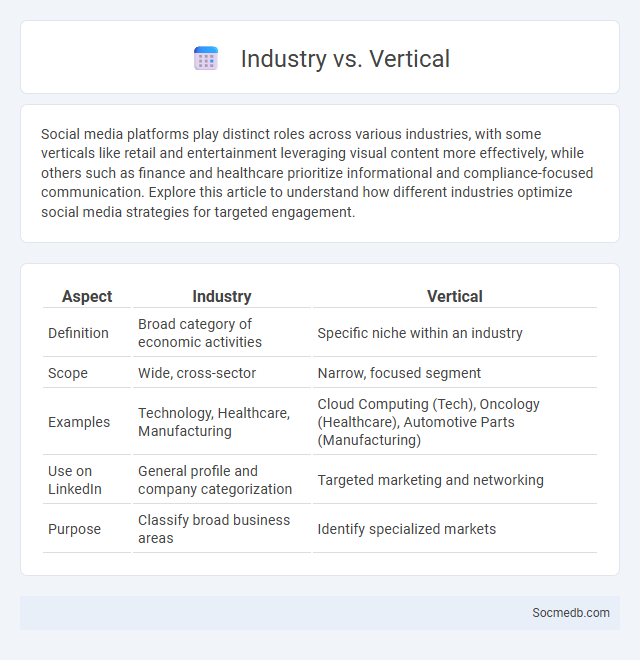
Photo illustration: Industry vs Vertical
Social media platforms play distinct roles across various industries, with some verticals like retail and entertainment leveraging visual content more effectively, while others such as finance and healthcare prioritize informational and compliance-focused communication. Explore this article to understand how different industries optimize social media strategies for targeted engagement.
Table of Comparison
| Aspect | Industry | Vertical |
|---|---|---|
| Definition | Broad category of economic activities | Specific niche within an industry |
| Scope | Wide, cross-sector | Narrow, focused segment |
| Examples | Technology, Healthcare, Manufacturing | Cloud Computing (Tech), Oncology (Healthcare), Automotive Parts (Manufacturing) |
| Use on LinkedIn | General profile and company categorization | Targeted marketing and networking |
| Purpose | Classify broad business areas | Identify specialized markets |
Understanding Industries and Verticals
Social media platforms offer unique opportunities for various industries and verticals to target specific audiences, enhance brand visibility, and drive engagement through tailored content strategies. Understanding trends, user behavior, and platform-specific algorithms helps your business optimize campaigns for sectors such as retail, healthcare, finance, and entertainment. Leveraging data analytics and industry insights ensures your social media efforts effectively meet the demands of your vertical.
Defining 'Industry' in Business Context
In the business context, the term "industry" refers to a specific category of economic activity characterized by companies producing similar goods or services, often competing within the same market. Social media platforms have become a vital industry segment, driving marketing, customer engagement, and brand visibility across digital landscapes. Understanding the social media industry's dynamics empowers you to strategically position your business and leverage digital opportunities effectively.
What is a Vertical Market?
A vertical market refers to a specific industry or group of businesses focused on a particular niche with specialized needs, such as healthcare, finance, or fashion. In social media, targeting a vertical market enables brands to create tailored content and advertising strategies that resonate deeply with a defined audience segment. This approach enhances user engagement, drives higher conversion rates, and maximizes return on investment by addressing the unique preferences and challenges of the niche.
Key Differences: Industry vs. Vertical
Social media strategies vary significantly between industry and vertical markets, with industries encompassing broad sectors like technology or healthcare, while verticals target specific niches such as fintech within technology or cardiology within healthcare. Industry-focused social media campaigns prioritize wide-reaching brand awareness and thought leadership, whereas vertical-focused approaches emphasize tailored content addressing the unique pain points and interests of a more specialized audience. Metrics also differ: industry campaigns track broad engagement rates and follower growth, while vertical campaigns measure conversion rates and lead quality within a defined segment.
The Role of Industry Insights
Industry insights provide critical data on social media trends, user behavior, and emerging platforms, enabling you to tailor content strategies effectively. Analyzing these insights helps identify audience preferences, optimize engagement, and enhance brand visibility across diverse channels. Leveraging real-time analytics ensures your social media campaigns remain relevant and competitive in a rapidly evolving digital landscape.
Vertical-Specific Insights: Why They Matter
Vertical-specific insights in social media enable businesses to tailor content and advertising strategies to the unique preferences, behaviors, and trends within specific industries or demographics. These insights drive higher engagement rates and more effective targeting by understanding platform usage patterns, competitive landscapes, and consumer sentiment specific to sectors like fashion, technology, or healthcare. Leveraging vertical-specific data enhances ROI by optimizing campaigns, content relevancy, and audience reach in social media marketing efforts.
How Businesses Use Industry vs Vertical Insights
Businesses leverage industry insights to understand broad market trends, competitor strategies, and regulatory impacts affecting social media engagement across multiple sectors. Vertical insights allow companies to tailor content, advertising, and customer interactions specifically to niche audiences within a particular industry, increasing relevance and conversion rates. Combining both insights enables businesses to optimize social media strategies, balancing wide-market awareness with targeted messaging for maximum impact.
Leveraging Insights for Market Advantage
Leveraging social media analytics provides businesses with actionable insights into consumer behavior, preferences, and trending topics that drive market advantage. By utilizing advanced data analysis tools, companies can tailor marketing strategies to target specific demographics more effectively, enhancing customer engagement and brand loyalty. Real-time monitoring of social media interactions enables rapid response to market changes and competitor movements, ensuring a competitive edge in dynamic commercial environments.
Practical Examples: Industry vs Vertical in Action
Brands in the fashion industry leverage Instagram to showcase seasonal collections through influencer partnerships, driving engagement within the apparel vertical. In contrast, financial services utilize LinkedIn to share expert analyses and regulatory updates, targeting professionals in the banking vertical. These strategic uses of platform features demonstrate how social media campaigns are tailored to industry-specific goals and vertical-focused audiences for maximum impact.
Trends Shaping Industry and Vertical Insights
Social media trends are rapidly evolving with the rise of short-form video content and immersive experiences like augmented reality driving higher user engagement across platforms such as TikTok and Instagram. Vertical insights reveal that industries like fashion, gaming, and e-commerce leverage influencer marketing and personalized ads to boost conversion rates effectively. Understanding these shifts allows Your brand to tailor strategies that maximize reach and foster meaningful connections with target audiences.
 socmedb.com
socmedb.com